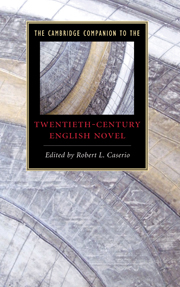Book contents
- Frontmatter
- Introduction
- 1 The art of English fiction in the twentieth century
- 2 The British Empire and the English modernist novel
- 3 Realism and rebellion in Edwardian and Georgian fiction
- 4 The Great War in English fiction
- 5 Postwar modernism in the 1920s and 1930s: The mammoth in the basement
- 6 Regionalism in English fiction between the wars
- 7 Ireland and English fiction
- 8 Feminist fiction
- 9 Working-class fiction across the century
- 10 World War II, the welfare state, and postwar “humanism”
- 11 The Windrush generation
- 12 History in fiction
- 13 Postmodernisms of English fiction
- 14 Detectives and spies
- 15 The post-consensus novel: Minority culture, multiculturalism, and transnational comparison
- 16 An absurd century: Varieties of satire
- 17 The other side of history: Fantasy, romance, horror, and science fiction
- Further reading
- Index
14 - Detectives and spies
Published online by Cambridge University Press: 28 July 2009
- Frontmatter
- Introduction
- 1 The art of English fiction in the twentieth century
- 2 The British Empire and the English modernist novel
- 3 Realism and rebellion in Edwardian and Georgian fiction
- 4 The Great War in English fiction
- 5 Postwar modernism in the 1920s and 1930s: The mammoth in the basement
- 6 Regionalism in English fiction between the wars
- 7 Ireland and English fiction
- 8 Feminist fiction
- 9 Working-class fiction across the century
- 10 World War II, the welfare state, and postwar “humanism”
- 11 The Windrush generation
- 12 History in fiction
- 13 Postmodernisms of English fiction
- 14 Detectives and spies
- 15 The post-consensus novel: Minority culture, multiculturalism, and transnational comparison
- 16 An absurd century: Varieties of satire
- 17 The other side of history: Fantasy, romance, horror, and science fiction
- Further reading
- Index
Summary
British detective fiction and spy fiction, descended from nineteenth-century adventure narratives, come of age in the twentieth century. Both emphasize action over character, and coincidence over probability; both qualify as thrillers. But despite their similarities, detective and spy genres have asymmetrical relations to each other. To view them as equal and merely conventional forms of mass-market entertainment obscures their differing subjects, narrative structures, and ideological values.
The subject matter of each genre is quite distinct. Detective fiction foregrounds antagonisms that inevitably concern bloodlines and inheritance within the UK. Spy fiction focuses on affairs of state between Britain and other nations. Detective narratives, unthinkable without a corpse, presume the finality of death as a meaningful event. In spy fiction violent deaths of characters are incidental to international conflict, and not mysterious in that context. Plots and plans vary widely in the two genres. A murderer in detective fiction acts according to a planned sequence of steps, but actions (including murder) in spy fiction arise from changing global circumstances. Detectives work alongside the police, drawing on their services, while showing superior ratiocinative ability. Spies, in contrast, subordinate themselves to directives from handlers in a central bureaucratic agency. Such subordination tempts spies to make renegade decisions. A spy defying orders in John le Carré's The Perfect Spy (1986) sums up quandaries in the genre thus: “Sometimes our actions are questions, not answers.”
- Type
- Chapter
- Information
- The Cambridge Companion to the Twentieth-Century English Novel , pp. 210 - 222Publisher: Cambridge University PressPrint publication year: 2009
- 2
- Cited by

